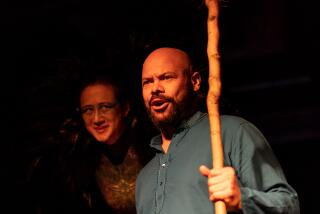SILENCE OF ACTOR STIRS A ‘TEMPEST’
- Share via
LA JOLLA — When Robert Woodruff agreed to direct “The Tempest,” opening Sunday at the La Jolla Playhouse, he had not planned on Caliban being a non-speaking role.
Then, he saw Howie Seago, a deaf actor, audition and was impressed by the power of his silence.
“In the course of the audition,” Woodruff said, “he showed me a side to Caliban that was dangerous and alive. It affected the way I decided the play was going to go.”
What Seago did was take Woodruff’s idea about setting the play in the colonial Third World and made it apply directly to his character.
“What Howie was doing made it more universal,” Woodruff said. “He had the pent-up fury of someone who had had his island taken away and had been living under someone who had taken it over for the past 12 years.”
The part means a great to deal to Seago, who played the lead role in Peter Sellars’ production of “Ajax” last year.
“I’m really excited about this because it proves that Ajax is not just a one-shot deal,” Seago said. “If people are intelligent and talented, they can modify some of the classical roles so that deaf people can play them.”
The modifications here entail finding other characters to speak the lines that Seago conveys with American Sign Language.
Woodruff and Seago see the modifications as adding an extra dimension to the play.
Seago sees his character’s insistence on signing as “a power struggle where Caliban refuses to speak in their language.”
Woodruff supports this idea by citing a passage in which Caliban tells Prospero and Miranda:
You taught me language, and my profit on’t
Is, I know how to curse. The red-plague rid you
For learning me your language!
So, instead of speaking, Miranda and Ariel interpret Caliban’s furious hand signals for the other characters--similar to the way the teacher in “Children of a Lesser God” signs for his angry student.
It’s an anger that Seago understands, referring to the deaf as “foreigners in the land of the hearing.”
While his character’s use of translators on stage is mirrored in Seago’s daily life off stage, the anger isn’t.
Seago, a tall, genial red-haired man, smiles easily. At 33, he has just left a teaching position at the National Technical Institute for the Deaf in Rochester, N.Y., to devote himself to acting full-time. His wife, Lori, who hears, is in Rochester, teaching English at the institute and caring for their 18-month-old son, Ryan David.
In a way, Seago said, his deafness, rather than holding him back, led him to acting.
“Because I did not have the ability to communicate with people on a fluent basis, it made me want to communicate in a more physical way,” he said.
Still, it was not until his freshman year at California State University, Northridge, that he learned the tools for his trade--sign language. Until then, he relied on lip reading, which can result in missing some of what is said. Now, to avoid any mistakes during the interview or in rehearsal, he tends to watch his translator, rather than the person who is speaking to him.
Then, unlike his stage characters, he vocalizes for himself, slurring lightly. His large, graceful hands slice through the air as he signs simultaneously.
His college roommate, who also was deaf, wanted Seago to try out for a play he was directing. Because Seago, unlike the other deaf actors, did not understand sign language, he memorized his hand movements. After the show, when deaf people in the audience came backstage to “speak” to him, he was embarrassed because he didn’t understand them.
It took him eight months to master the American Sign Language and, later, he started a theater troupe of his own. His group, which traveled to various cities in California, led to an offer after graduation as associate producer, writer and director of “Rainbow’s End,” an educational-entertainment series for deaf children.
During his four years at “Rainbow’s End,” he got married and met his current translator, Rico Peterson. Afterward, he joined the National Theater of the Deaf, where Sellars directed him in a short piece and told him they would work together again. Sego didn’t count on it. He went on with his life, working on “Beauty and the Beast” in Hawaii--his first part that was modified so that the audience wasn’t aware he was deaf--and later on a revival of “Children of a Lesser God” for Mark Medoff in New Mexico.
Then, 4 1/2 years after Sellars’ promise, the director called. The play was “Ajax.” What followed were rave reviews for Seago on both coasts (it played in the Kennedy Center in Washington before being staged at the Playhouse) and in Europe, where Seago and the rest of the cast just finished traveling with it.
For Seago, the most exhilarating parts of the European tour were the curtain calls--they got three or four a performance, topping off with seven one night--and the reviews that generally dwelt on his performance, without mentioning his deafness.
“I’m delighted that they see it that way,” he said. “That I’m an actor first.
“Sometimes, I think a lot of hearing people are easily influenced by the fact that I’m deaf. I don’t like that condescension.”
He shrugged his shoulders and laughed. “I’ll take advantage of it.” Then, turning serious, “But I would like people to see my acting ability on its own.”
More to Read
The biggest entertainment stories
Get our big stories about Hollywood, film, television, music, arts, culture and more right in your inbox as soon as they publish.
You may occasionally receive promotional content from the Los Angeles Times.










